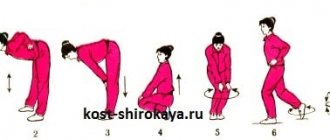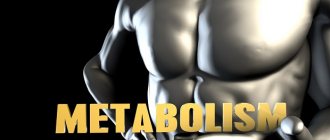© ogichobanov — depositphotos.com
Share:
Almost every athlete knows that it is impossible to grow all the time. Everyone struggles with this in their own way. It was precisely because of the impossibility of constant growth that hard gainers appeared in their time. Have you seen bodybuilders who eat on a schedule and constantly ingest anabolic steroids? Why is all this needed? The answer lies in one word - catabolism.
The essence
Catabolism is a direct component of metabolic processes in the body. What is she like? It’s very simple – it’s resource optimization. Our body works like a pendulum, constantly creating new cells and destroying old ones. In fact, in 5 years you are completely renewed, being a different person. But that's not all.
In a biochemical understanding, catabolism is the breakdown of complex substances into simpler ones or the oxidation of various molecules. The process occurs with the release of energy:
- heat;
- ATP molecules are the main source of energy for any biochemical reaction.
Catabolism and anabolism are in constant balance, and directly depend on the following factors:
- Hormones, since these substances are the main regulators of catabolism and anabolism.
- The need to change the balance.
- Food.
- Metabolic rates.
- Amount of sleep.
- Other factors.
Let's look at a simple example of the processes of optimizing the body's resources. Initially, during the day, the body strives to break down energy and synthesize new cells.
At night, a reboot occurs, and it begins to kill unnecessary cells, breaking them down, and preparing for renewal.
In case of stress loads, catabolic processes are significantly accelerated. However, in this case, the acceleration of catabolism occurs in preparation for a powerful anabolic surge. All cells that are unable to withstand new levels of stress are killed and destroyed, replaced by more powerful and stronger ones.
Loads are precisely the factor that influences the shift in the balance between anabolic and catabolic processes.
When the stress in the body passes (for example, a person stops playing sports), the smart body optimizes resources so that it can survive in the event of a hunger strike or other powerful stress. And we all see muscle breakdown. This is especially noticeable if you follow athletes after their careers end. Usually they lose up to 40% of the accumulated muscle mass.
It is important to understand that physical activity is not the only factor that changes the balance between catabolism and anabolism. Any change in your daily routine or diet can move the slider in one direction or another.
© ogichobanov — depositphotos.com
What is the connection between sleep and anabolism?
Sleep is a complex neurophysiological process. There are many effects that sleep has on the human condition, but they are not the subject of this article. Here we will consider only the association of the process of anabolism and sleep.
At night, when the brain is immersed in sleep, the body works “more economically” - the pulse and heart rate slow down. Night is the kingdom of the Vagus or vagus nerve - that part of the nervous system that belongs to the parasympathetic. This means that the processes of digestion and assimilation of food within the small intestine are more efficient. This is a plus for anabolism. In addition, inflammatory processes intensify and become more intense. This means that we quickly reach the third, desired phase of the inflammatory process.
The process of anabolism is caused not only by sex hormones. Somatotropin, also known as growth hormone, plays an important role in this process. And the time when it is released in greatest quantity is at night.
Conclusion: sleep has a very positive effect on the anabolism process.
© edesignua — depositphotos.com. Circadian rhythms
Physiology
The physiology of catabolism consists in the breakdown of substances followed by their oxidation. During metabolic processes, any activity provokes the onset of a general path of catabolism. During a stressful situation (muscular/mental tension), the body begins to consume huge amounts of glycogen. Subsequently, if there is sufficient oxygen in the blood, the breakdown of ATP in muscle tissue occurs, which provokes destruction and microtrauma of muscle tissue.
Note: Catabolism is not always a bad thing. After all, the process concerns not only muscle, but also adipose tissue. In particular, many diets and training complexes for cutting imply the activation of catabolic processes to remove lipids from insulin-opened cells, followed by their breakdown into energy and oxidation.
Stages of anabolism
Strictly speaking, it is impossible to distinguish any specific stages of anabolism. However, if we delve deeper into the question of what happens in the process of anabolism, we can conditionally divide this process into the following phases:
| Hormonal stage | Here hormones are secreted by the endocrine glands and subsequently delivered to the cells. Having passed through the cell membrane (read more about this below), hormones pass to the cell nucleus. If a trainee uses drugs, in particular AAS, a syringe “releases” hormones into the blood instead of the endocrine glands. Everything else will happen exactly the same as for someone training “naturally,” but with greater speed and intensity. |
| DNA activation stage | A number of processes occur in the cell nucleus that lead to the reading of genetic information, its doubling and the launch of the third stage of anabolism. |
| Muscle protein synthesis stage | At this stage, our body needs those same nutritional substrates that ordinary people love to talk about - proteins, or more precisely, the amino acids from which they are composed. It is the amino acids obtained from food (or from sports supplements - there is no difference) that will become the “building blocks” from which the tissues of our body will be synthesized. |
Stages
Since catabolism is a cyclic procedure, it has active and passive phases combined with anabolism. Let's take a closer look at the stages of catabolism:
- Stage one is stress.
- Stage two is destruction.
- Stage three – super recovery.
- The third alternative stage is optimization.
- Stage four – balance.
From the first stage, the body begins to actively consume reserve resources. Stress is considered to be almost all human activity that goes beyond his usual daily routine. Thus, muscle catabolism can provoke:
- Changing your daily routine, reducing sleep.
- Unusual strain on muscles.
- Changing your meal plan.
- Increased consumption of adrenaline stimulants.
In the process of receiving stress, the body begins to destroy reserve resources (starting from glycogen reserves, which are also stored in muscle tissue, and ending with the muscles themselves). If the body has reserve sources of energy or timely replenishment is provided, then the process of super recovery begins.
Interesting fact: have you noticed that during mental stress, the body actively requires sweets? Or the fact that girls eat away all their problems and sorrows with cakes and sweet tea. So, this is a consequence not only of the presence of “pleasure hormone” stimulants, but also a natural need of the body to restore strength and prepare the body for possible stress.
If the body does not have reserve funds for recovery, then the optimization stage begins. At this moment, the synthesis of ATP and glycogen stops, and the body itself reduces energy consumption due to the destruction of energy consumers.
The most important energy consumers are the muscles and the brain.
Conclusion: fasting causes not only a decrease in muscle mass, but also brain destruction. Therefore, people who are constantly in a calorie deficit actually become dumber than their well-fed counterparts.
After optimization (super-recovery) is completed, the body brings anabolic and catabolic processes into balance. This stage usually takes up to 48 hours while the body stabilizes.
Note: For the same reason, people not taking anabolic steroids should take at least 48 hours between workouts.
Catabolism processes include:
- tissue oxidation;
- change in ATP balance;
- cessation of ATP synthesis;
- breakdown of amino acids into energy.
- changes in lipid balance;
- change in the size of glycogen depot.
This is not all that happens during catabolism.
In general, in biochemistry, the stages of the general catabolic pathway are as follows:
- Digestion in the gastrointestinal tract is a chain of reactions that convert complex molecules into simpler metabolites. This is how glucose, fatty acids, and amino acids are obtained.
- Specific catabolic pathways are the breakdown of simple metabolites to pyruvic acid or acetyl-CoA.
- Oxidative decarboxylation of pyruvate, citrate cycle, respiratory chain - the final stage of catabolism, as a result of which final products are formed from food components (source - Textbook “Biological Chemistry”, Severin).
The biochemical processes are quite complex, and in each case, catabolism occurs individually.
Anabolic steroid
Anabolic steroids are androgenic hormones that are naturally occurring (such as testosterone) or produced synthetically and mimic the effects of testosterone. Androgens are anabolic; they increase protein in muscle cells, which causes an increase in muscle mass. Anabolic steroids are used to treat certain medical conditions, such as delayed puberty in boys, and they can also be used for muscle growth, to stimulate appetite, to produce secondary sexual characteristics in transgender men, and to treat certain conditions that may lead to loss of sex. muscle mass, such as cancer and AIDS.
However, sometimes anabolic steroids are also abused by athletes who want to quickly build muscle mass. Most major sporting organizations prohibit doping and the use of anabolic steroids or other performance-enhancing drugs to prevent steroid abuse. Although steroid use can increase muscle mass, it also has many side effects. They range from acne to high blood pressure to aggression (“rabid rage”) and even psychosis. Steroids can affect the structure of the heart, which can lead to congestive heart failure or heart attack. They also have an adverse effect on cholesterol levels, can stunt growth, and can cause liver damage in high doses.
In women, steroids can cause masculinization, which is the development of secondary sexual characteristics in men, such as a deeper voice, increased body hair, enlargement of the clitoris (the clitoris in women is homologous to the penis in men), and temporary menstrual irregularities. However, in men, steroids can cause feminization, including breast development. tissue and decrease in testicular size. This is because testosterone can be converted to estradiol, a female sex hormone. The effects of masculinization and feminization tend to be reduced/reversed when a person stops taking steroids and their hormone levels return to normal.
- catabolism – A set of processes that break down large molecules into smaller ones.
- Metabolic Pathway – A series of chemical reactions in a cell.
- macromolecule – A very large and complex molecule.
- Anabolic steroids are hormones used to treat conditions that require increased muscle mass; they are also sometimes abused by athletes.
How to slow down?
Considering the specific and general pathways of catabolism, we can conclude that it is impossible to stop catabolism. At the same time, you can look for ways to slow it down.
The rate of catabolism is directly related to the rate of metabolism. Despite the fact that people think that a slow metabolism leads to weight gain and leads to catabolism, this is not entirely true. Therefore, if your goal is to slow down catabolism, there are 3 main ways:
- Increase the time of anabolic processes.
- Reduce stress on the body.
- Slow down metabolism.
To increase anabolic processes, you need to constantly feed the body with energy and builders.
That is why experienced bodybuilders eat 5-8 times a day, strictly at certain times.
To increase the time of anabolic processes, you need to eat hard-to-digest foods (complex carbohydrates, rich in fiber), and consume at least 2 grams of protein per kilogram of net weight.
Reducing stressful situations for the body is easier to achieve. Don't move, sleep and feel joyful emotions. A day off/vacation/break between workouts can help with this. 8 hours sleep, and a bar of dark dark chocolate.
Slowing down metabolism is extremely easy to achieve - you just need to create a situation in which metabolic processes slow down extremely. A good way is to sleep a lot. A bad way is to stop eating.
Metabolism concept
Metabolism can be defined as a set of biochemical processes occurring in any living organism, including the human body. Metabolism is needed to ensure the vital functions of organs and systems, and these chemical reactions allow us to grow, adapt to environmental conditions, heal wounds, reproduce, etc. Metabolic processes are divided into two types:
- assimilation (constructive processes or anabolism);
- dissimilation (destructive processes or catabolism).
Products to slow down catabolism
As we mentioned earlier, in sports disciplines it is important to maintain the right balance between anabolism and catabolism.
However, you don’t have to take anabolic steroids for this. It is enough to use products that reduce the rate of catabolism, thereby provoking a positive balance of anabolic processes in relation to catabolism.
| Product | Impact principle |
| Ginger root | Is a direct stimulator of androgen hormone production |
| Caffeine | Is a powerful adrenaline stimulant |
| Lemon | Vitamin C – slows down the processes of oxidation and muscle breakdown |
| Meat | Protein structure that allows you to shift the balance of anabolism relative to catabolism |
| Eggs | Protein structure that allows you to shift the balance of anabolism relative to catabolism |
| Milk | Protein structure that allows you to shift the balance of anabolism relative to catabolism |
| Tribulus | Is a direct stimulator of androgen hormone production |
| Complex carbohydrates | Stops the breakdown of muscle structures for energy |
| Polysaturated omega 9 acids | Are harbingers of cholesterol |
| Products containing healthy cholesterol | Cholesterol – allows you to significantly increase the production of anabolic hormones, reducing the level of catabolism to almost zero |











